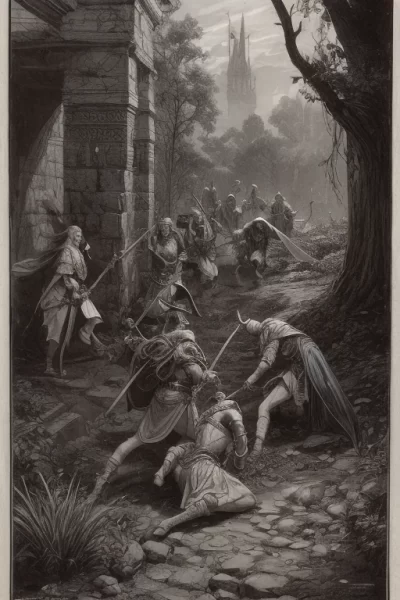Resurrection spells in Dungeons and Dragons 5th Edition are incredibly useful for any party to have. Supportive classes like Clerics or Bards are easy choices for giving resurrection spells, but having a Wizard or Warlock learn a few can be incredibly handy as well.
Nothing can top the ability to revive a dead teammate, and the lower-level spells that can resuscitate a downed target or force a dead body to become your thrall can find a place in the right builds.
Since resurrection can take different forms, this article will cover the best resurrection spells to pick for your Dungeons and Dragons 5th Edition adventures. The entries in this list are ordered by spell level strength, so keep in mind your available spell slots when reading and choosing your abilities.

1. Spare the Dying (Cantrip)
This cantrip is simple: the caster touches a living creature that has 0 hit points, stabilizing them. Constructs and undead are unaffected by this spell. This is an easy way to prevent death-saving throws without spending valuable health potions or spell slots to heal the target.
At low levels, such as early in campaigns, this cantrip can become invaluable. At high levels, this cantrip allows for better resource allocation during powerful encounters. With some creativity, this cantrip can support the party outside of healing- if a boss needs to be captured alive, bringing them to 0 then casting Spare the Dying can help with the process.
Overall, this cantrip should definitely be taken at early levels and be heavily considered in later levels of the game.
2. Gentle Repose (2nd Level)
While not exactly resurrection, our first 2nd-level spell is Gentle Repose, a spell that prevents decay on a corpse or bodily remains. The target cannot become undead nor can it decay or wither beyond its current state. It also extends the time limit on targets that are already raised from the dead, such as zombies being used as thralls.
Since the spell lasts for 10 days, some creativity will get a lot of mileage out of the 2nd-level spell slot required for casting. If working with another necromancer, this spell can support their dark endeavors.
If you have a fallen companion and know someone capable of truly bringing them back to life, this spell will buy you the necessary time for traveling or raising the funds for revival.
3. Revivify (3rd Level)
Revivify offers the means to resurrect a recently deceased creature, provided that their death occurred within the last minute. It’s a valuable spell for quickly restoring fallen allies to the land of the living.
The spell may seem overpowered for only being at the 3rd Level, and it is- to an extent. Bringing a dead creature back to life, even with a single hit point, will always be powerful no matter the level of the spell.
However, Revivify’s limitations are shown when trying to revive a create that has died of old age or that is missing body parts, as the spell will fail and your spell slot will still be consumed. Keep in mind the status of the target and the circumstances of their death before casting this spell.
4. Death Ward (4th Level)
Death Ward safeguards against death’s clutches, allowing the target to avoid falling to 0 hit points when reduced to 1. While it doesn’t resurrect, it prevents the need for resurrection in the first place.
The spell also negates the effect of any damage-less instant kill abilities before ending, making Death Ward one of the few safeguards against Power Word Kill, and certainly one of the cheapest options as well.

5. Raise Dead (5th Level)
Raise Dead resurrects a character who has been dead for no longer than ten days. Remember, having Gentle Repose can extend the time limit on Raise Dead and spellslots are regained upon long rests.
This spell requires a willing spirit, making it a cooperative effort between the caster and the revived character. Nonmagical diseases and effects are removed upon casting the spell, but magical versions of these effects remain in the target’s body.
Like Revivify, missing limbs and important organs are not restored, so be positive about the state of the body before casting Raise Dead to not waste a spell slot. Lastly, the revived target does suffer a penalty due to the ordeal that is returning to life. This penalty to rolls goes away with time via long rests.
6. Reincarnate (5th Level)
Reincarnate resurrects a deceased character by placing their soul into a new body. The result can be a change in race, offering a unique role-playing opportunity.
The reincarnated creature can recall its past life’s experiences, but it must now live through the body chosen by the DM based on the result of their d100 roll. All capabilities are retained, except any racial traits are swapped out accordingly for the new race.
7. Soul Cage (6th Level)
Soul Cage captures the soul of a recently deceased creature, allowing the caster to manipulate it or use it for a specific purpose. While not a direct resurrection spell, it deals with the soul after death, offering the potential for resurrection but fully playing into necromancer flavorings.
This spell offers many ways to utilize the trapped soul, from stealing its essence to heal yourself to asking questions and incurring advantages on your rolls. Perhaps the aspect that requires the most creativity, however, is Eyes of the Dead. This allows the caster to create an invisible sensor in a location the trapped soul knew in life.
The caster can then look through the sensor to gain visual and auditory information as if standing there themselves. Once the spell meets its maximum uses, the soul is freed and can return to its body granted it has a means to revive itself.
8. Resurrection (7th Level)
Resurrection is another powerful revival spell for returning the dead to the land of the living. Like the previous revival spells, this spell only works if the soul is willing and if the body meets specific conditions, although the conditions are much less restrictive.
Old age and the undead are both unaffected by Resurrection, but any missing limbs are restored and mortal wounds are closed. This effectively makes it the strongest resurrection spell on our list so far, and one of the best to have as both a supportive means and as a last resort if a party member were to die.
9. Clone (8th Level)
Clone is a unique entry to this list. While not exactly a resurrection spell, Clone creates a replica of a living creature over the course of 120 days. Once the chosen creature’s clone grows, it remains in its vessel until the original dies. Once the original dies, their soul can willingly join the body of the clone, essentially being reborn.
The caster can choose a younger body for the clone they create or use an exact replica, allowing the caster to avoid death by old age if that is a possibility. Once the clone becomes the host of the soul, the original body becomes inept and is unable to be revived. Clone has a dark tone to its usage, but the spell can still be useful and offer creative situations for both players and DMs.
10. True Resurrection (9th Level)
True Resurrection stands as one of the most potent revival spells in the game. It can bring back a creature with nearly no limits to the spell’s use. Old age still is unaffected, but all wounds and magical afflictions on the body are cured. If the body is unable to be restored or retrieved due to total destruction, a new body can be created.
With some creativity and with the Dungeon Master’s discretion, True Resurrection can even bypass its own limits, such as offering a new body for the soul if theirs is withered from age, but the soul is still young. If you have room for it, taking True Resurrection as your 9th-level spell will greatly help your party reach or maintain its goals.
11. Wish (9th Level)
Wish, the most powerful spell in the game, can achieve nearly anything, including resurrection. While not its primary purpose, a Wish spell can bring back a deceased character to life or reverse other catastrophic events.
However, using Wish for resurrection carries risks and is at the Dungeon Master’s discretion. We include this spell because it can be used by most spellcasters, even the non-necromancers, to control or revive the dead.
Conclusion on Best 5e Resurrection
This article covered the best resurrection spells in Dungeons and Dragons 5th Edition. Some spells, such as Speak with Dead, did not make the cut, but they are still useful if you have the room or if the spells fit your character’s flavor. Feel free to use this list as a reference or take all the spells for full optimization.
Regardless of what you choose or how you play, resurrection spells are among the strongest utility spells in the game and can turn the tides of high-stakes encounters in your favor. Bending the rules of nature comes at a cost, but if you are willing to pay that price, then work with your Dungeon Master and table to create unforgettable experiences in your campaigns.
